- June 26, 13:05 (GMT+2)
Project defined and early preparations.
- July 1, 22:10 (GMT+2)
-
So the challenge begins. I start off with a reasonably light
task. A while ago I bought a portable DVD player with dual 7" wide TFT
screens that connect to the player through a four band 3.5 mm jack.
I previously bought some adapter cables off eBay hoping those would be plug
and play, but it seems there are many different ways to position the four
signals of composite video, sound left/right and ground. At best I got a
picture with a lot of disturbance.
More recently I bought a few solderable jacks to make my own cable, and the
first task was to identify which band and solder tab corresponds to which
signal.
It is quite possible that this pinout indeed matches one of the known
standards for carrying the signals, but just in anyone else got a DMTECH
PDV891-2 (same model number on both the complete package as on the TFT screens
individually), I decided to post my findings here.
The trusty old terminal blocks are my first choice when it comes to
temporary joints. Unlike last time with the Olivetti PC-1, this one only had
four leads to try. Once I figured out the ground, the other three were rather
quick to identify.
Since the display is wide, it doesn't really do a 4:3 display
justice. Some of the text/graphics are shrunken, which means while you probably
can play most action games, you would not use this type of display for word
processing or even text adventures would be annoying to read the text.
In any case, I am off and ready to solder two proper cables to let me hook
up just about any device outputting composite video and sound to these small
displays, possibly useful on an exhibition or similar where the image quality
is not first priority, but to get some visual and sound at all.
Oh yes, I actually took a head start on the challenge when I
finished off a ZX Spectrum crap game the night before. It hasn't yet been
posted to the compo site though. I might get around doing some more of those
in the next weeks, or I aim at programming something proper.
- July 7, 21:25 (GMT+2)
-
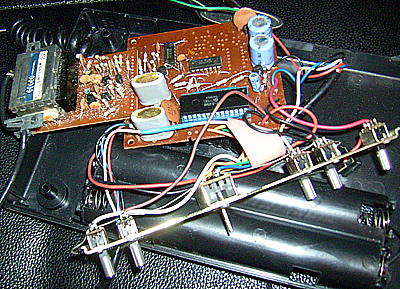 Not much has happened in the past week, too busy and tired with other matters.
However tonight I dug out a broken Otron Gamatic 7704 Color (!) Pong game that
I swapped for a couple of years ago. The previous owner may have plugged in AC
power or at least the wrong polarity, and zapped something in the process. That
is why he took it apart and left the game to its destiny.
Not much has happened in the past week, too busy and tired with other matters.
However tonight I dug out a broken Otron Gamatic 7704 Color (!) Pong game that
I swapped for a couple of years ago. The previous owner may have plugged in AC
power or at least the wrong polarity, and zapped something in the process. That
is why he took it apart and left the game to its destiny.
I am not very good at troubleshooting electronics. I got as far as measuring
9V at the power input, but only a measly 0.59V at the VSS and VCC pins on the
AY-3-8500 chip. It should be about 6-7V as far as I understand. I suspect the
470 uF capacitors may have blown, but my spares are used and of unknown state,
so I'd better get some fresh ones before soldering.
To make sure that the "heart" of this system is OK, I moved the AY chip from
this carcass to a Coleco Telstar Pong game that has an identical chip. It plays
allright with both AY chips, so it suggests at least this one survived. There
are a few smaller CMOS 40xx chips too, which may or may not have been damaged,
but if so, those are easier to replace.
I also found some schematics at simple Pong implementations using the same
AY chip, so perhaps I'm better off at routing a new circuit and perhaps
transplanting the controllers, than trying to fix this one although it doesn't
seem like an awful lot of components that could have gone bad.
- July 14, 23:45 (GMT+2)
-
Another week, and the most retro related I've been doing is to
play games. Tonight I resoldered a loose wire on my uIEC/SD, but it was a two
minute job and not much to write about in Retrochallenge related matters.
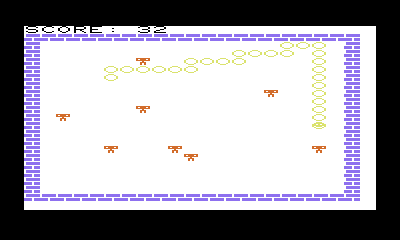 Instead I returned
to an old VIC-20 game I was working on five years ago. I call it Berznake, as
it is meant to be a mix of a regular snake/surround game and Berzerk. Instead
of shooting the robots, your snake will run over them. As they're robots, they
will move around.
Instead I returned
to an old VIC-20 game I was working on five years ago. I call it Berznake, as
it is meant to be a mix of a regular snake/surround game and Berzerk. Instead
of shooting the robots, your snake will run over them. As they're robots, they
will move around.
I'm not sure if I will introduce that robots can shoot, but I previously had
an idea about introducing bombs that the robots can place to trap the snake.
I've considered adding human characters that would be able to disarm the bombs,
but are at risk of being killed by robots, to make it even more complex.
Right now the game has neither bombs nor humans, but perhaps at the end of the
month, some five years after I started on the game?
- July 19, 23:55 (GMT+2)
-
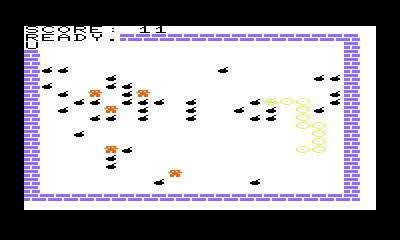 A
small step for a man, but a giant leap for robotkind!
A
small step for a man, but a giant leap for robotkind!
Yes, I have implemented bombs. At the current rate, there is a 33% chance
that a robot will drop a bomb when the robot moves. I believe that might be a
bit too often, and may tune it down to perhaps 1/5 or even 1/10.
I also changed the graphics slightly, as I think these robots look a bit
better. So far though I haven't implemented humans, nor have I implemented
levels with different arrangements of barriers, which the humans should be
able to dig through.
Something else I haven't developed is any kind of sound or music, although
it is a bit of my speciality. It probably will be the last I add, much to keep
the fun part to the end.
In other Retrochallenge related news, nothing has happened. Well, I finished
up the cable to the 7" TFT screen so it is permanent with sound. I found
that the VIC-20 display fares much better on the 4:3 to 16:3 conversion than
the C64 does, probably because the image is made up of fewer logical pixel
lines so a bit of shrunkage here and there doesn't show as much. I also tried
the Nintendo Famicom, which looks good but in B&W as it is a Japanese NTSC
unit and this screen apparently only groks PAL.
I also got some hints on the pinout for the Olivetti PC-1 which I played
with in the Winter Warm-Up this year. According to my source, the pinout really
should be according to standard numbering, at least for RGB output, which is a
bit odd but one of those days I'll try it and see if I get the desired results.
- July 21, 22:30 (GMT+2)
-
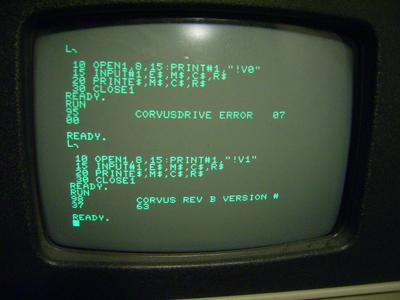 Tonight I gave one of my last remaining PETs some love. Or actually
I was asked to run some tests and report the results, which is why I powered it
on in the first place.
Tonight I gave one of my last remaining PETs some love. Or actually
I was asked to run some tests and report the results, which is why I powered it
on in the first place.
What you don't see in this picture, is my Corvus hard drive setup. It is
connected through a Small Systems Engineering (SSE) HardBox to the PET, in this
case a non-CRTC 4032.
The hard drive in question is the 6 MB model, which as far as I understand
formats as 5 MB... or perhaps I misunderstood something. Corvus also sold
drives in the sizes of 10 MB and 20 MB and multiplexers to have many PETs share
one drive, of which I used to own all but sold/donated the others.
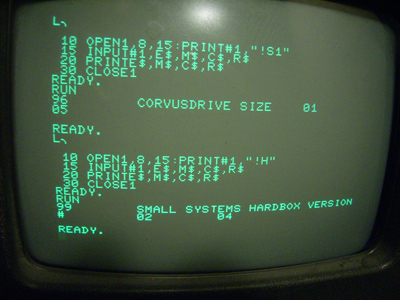 Today, the PET powered
on fine on first attempt, but on second attempt it began to fail to boot;
partial startup messages and garbage until it dumped into the monitor. Usually
one would start to sweat at this point, but as most PET owners know, these
computers often require a recurring round of pushing down the socketed chips
so I unscrewed the two bottom screws and gave them all a firm press.
Today, the PET powered
on fine on first attempt, but on second attempt it began to fail to boot;
partial startup messages and garbage until it dumped into the monitor. Usually
one would start to sweat at this point, but as most PET owners know, these
computers often require a recurring round of pushing down the socketed chips
so I unscrewed the two bottom screws and gave them all a firm press.
After the maintenance, it booted OK again and I was back to reading version
numbers off the drive. So this is a 5.. 6.. whatever megabyte drive of revision
B and version 37.63. It is connected to a SSE HardBox of version 2.04 or if
that simply should be 2.4.
Well, that's as far as I got tonight, which practically is
nowhere but at least I keep up the good intention of the challenge, to do
something retro related. :-)
- July 26, 22:35 (GMT+2)
-
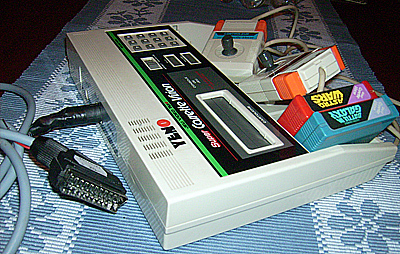 Today
I visited a friend and bought a Yeno Super Cassette Vision, the French release
of the Japanese Epoch video game from 1984. After some quick research, I found
that it takes 8.5 - 9V DC, centre polarity negative just like a ZX Spectrum,
Nintendo Famicom or Sega Megadrive/Genesis so that was easy to source.
Today
I visited a friend and bought a Yeno Super Cassette Vision, the French release
of the Japanese Epoch video game from 1984. After some quick research, I found
that it takes 8.5 - 9V DC, centre polarity negative just like a ZX Spectrum,
Nintendo Famicom or Sega Megadrive/Genesis so that was easy to source.
However the unit came with a strange, very short 5-pin DIN to SCART cable
that didn't yield any video whatsoever. After looking at which pins in the
SCART cable were used, I figured this cable would never output RGB.
By chance I plugged in the 7-pin DIN to SCART cable from my Matra Alice,
thinking perhaps there is a French DIN standard for RGB video. I got a black
and blue image with a lot of noise, but it showed that the console was
alive.
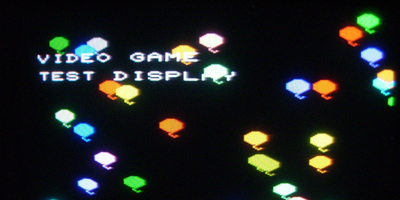 Another round of
searching pointed me to a
RGB pinout extracted from a Japanese page. To speed up the work, I reused
the cable I prepared in my previous Olivetti PC-1 experiments, as I had
soldered up all pins in a 8-pin "C" connector. Then I reused the SCART
connector from one of those $3 cables found at the goodwill store, and soldered
the wires in place.
Another round of
searching pointed me to a
RGB pinout extracted from a Japanese page. To speed up the work, I reused
the cable I prepared in my previous Olivetti PC-1 experiments, as I had
soldered up all pins in a 8-pin "C" connector. Then I reused the SCART
connector from one of those $3 cables found at the goodwill store, and soldered
the wires in place.
Of course I had got the DIN pinout backwards, which I figured out very soon
and not much time was lost. I also mixed up audio in and out on the SCART side,
which took a few runs.
What I didn't wire up is the blanking switch to force the TV into RGB mode,
as I didn't quite figure out the easiest way to get 5V into 3V, if I need to
use two resistors and one going to ground, if I can get away with a diode or
another simple way to do it. For the moment I'll leave it at that, as it isn't
that much work to manually switch to RGB mode on TV sets that require it.
For those who would not want to solder their own cable, I saw that one can
buy ready made ones for £9.99 but as I already had all the parts at home,
partly ready made, I both saved time and money and got at least some credits
for doing it myself.
- August 1, 22:20 (GMT+2)
-
So another challenge has passed, or rather I noticed the deadline
was extended to Sunday, August 3rd but as I have no real project to finish, I
conclude this one now. While I got a few small matters done, none of it added
anything for others to benefit from.
Today I bought a pack of assorted electrolytes, and replaced the two 470 uF
ones on the Gamatic 7704 Pong game above, with no difference. There is another
10 uF one that I didn't obtain a replacement for, but I suppose the fault is
elsewhere or more complicated than just a broken capacitor. I suppose the three
transistors on the board should be checked as well, or maybe I should build a
new Pong game from schematics found on the web, using the apparently still
working AY-3-8500 chip.
On the programming front, I will slowly make progress as time and motivation
allows, but nothing finished by the end of this challenge.
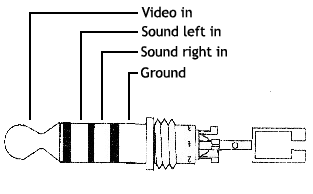
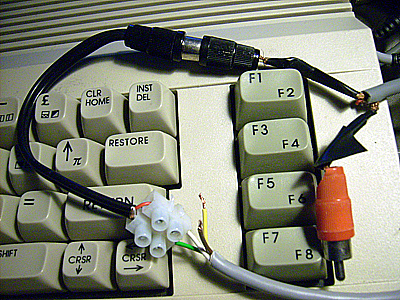
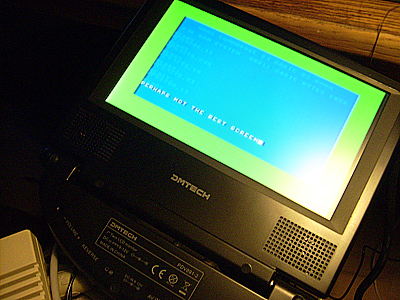
 Not much has happened in the past week, too busy and tired with other matters.
However tonight I dug out a broken Otron Gamatic 7704 Color (!) Pong game that
I swapped for a couple of years ago. The previous owner may have plugged in AC
power or at least the wrong polarity, and zapped something in the process. That
is why he took it apart and left the game to its destiny.
Not much has happened in the past week, too busy and tired with other matters.
However tonight I dug out a broken Otron Gamatic 7704 Color (!) Pong game that
I swapped for a couple of years ago. The previous owner may have plugged in AC
power or at least the wrong polarity, and zapped something in the process. That
is why he took it apart and left the game to its destiny. Instead I returned
to an old VIC-20 game I was working on five years ago. I call it Berznake, as
it is meant to be a mix of a regular snake/surround game and Berzerk. Instead
of shooting the robots, your snake will run over them. As they're robots, they
will move around.
Instead I returned
to an old VIC-20 game I was working on five years ago. I call it Berznake, as
it is meant to be a mix of a regular snake/surround game and Berzerk. Instead
of shooting the robots, your snake will run over them. As they're robots, they
will move around. A
small step for a man, but a giant leap for robotkind!
A
small step for a man, but a giant leap for robotkind! Tonight I gave one of my last remaining PETs some love. Or actually
I was asked to run some tests and report the results, which is why I powered it
on in the first place.
Tonight I gave one of my last remaining PETs some love. Or actually
I was asked to run some tests and report the results, which is why I powered it
on in the first place. Today, the PET powered
on fine on first attempt, but on second attempt it began to fail to boot;
partial startup messages and garbage until it dumped into the monitor. Usually
one would start to sweat at this point, but as most PET owners know, these
computers often require a recurring round of pushing down the socketed chips
so I unscrewed the two bottom screws and gave them all a firm press.
Today, the PET powered
on fine on first attempt, but on second attempt it began to fail to boot;
partial startup messages and garbage until it dumped into the monitor. Usually
one would start to sweat at this point, but as most PET owners know, these
computers often require a recurring round of pushing down the socketed chips
so I unscrewed the two bottom screws and gave them all a firm press. Today
I visited a friend and bought a Yeno Super Cassette Vision, the French release
of the Japanese Epoch video game from 1984. After some quick research, I found
that it takes 8.5 - 9V DC, centre polarity negative just like a ZX Spectrum,
Nintendo Famicom or Sega Megadrive/Genesis so that was easy to source.
Today
I visited a friend and bought a Yeno Super Cassette Vision, the French release
of the Japanese Epoch video game from 1984. After some quick research, I found
that it takes 8.5 - 9V DC, centre polarity negative just like a ZX Spectrum,
Nintendo Famicom or Sega Megadrive/Genesis so that was easy to source. Another round of
searching pointed me to
Another round of
searching pointed me to